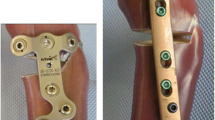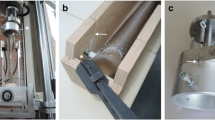Abstract
Since a significant number of implant failures have been reported in association with the procedure of open wedge valgus high tibial osteotomy, the initial biomechanical stability of different fixation devices was investigated in this study. Fifteen third generation Sawbones composite tibiae were used as a model. Four different plates were tested: a short spacer plate (OWO) (n=4), a short spacer plate with multi-directional locking bolts (MSO) (n=5), a prototype version of a long spacer plate with multi-directional locking bolts (MSOnew) (n=2), and a long medial tibia plate fixator with locking bolts (MPF) (n=4). All opening wedge osteotomies were performed by the same surgeon (PL) in a standardized fashion. Axial compression of the tibiae was performed using a materials testing machine under standardized alignment of the loading axis. Single load to failure tests as well as load-controlled cyclical failure tests were performed. The required force and cycles to failure were recorded. Osteotomy gap motion was measured using linear displacement transducers. Residual stability after failure of the opposite lateral cortex was analysed. Failure occurred at the lateral cortex bone-bride in all tested implants. The rigid long plate fixator (MPF) resisted the greatest amount of force (2,881 N) in the single load to failure tests. In the cyclical load-to-failure tests, the constructs with MPF resisted more than twice the amount of loading cycles when compared to the short spacer plates. The osteotomy gap motion was smallest in the MPF, with a reduction of the displacements of up to 65, 66 and 88%, when compared to OWO, MSO and MSOnew, respectively. The highest residual stability after failure of the lateral cortex was observed in MPF as well. The results suggest that the implant design strongly influences the primary stability of medial opening wedge tibial osteotomy. A rigid long plate fixator with angle-stable locking bolts yields the best results.













Similar content being viewed by others
References
Bauer T, Hardy P, Lemoine J, Finlayson DF, Tranier S, Lortat-Jacob A (2005) Drop foot after high tibial osteotomy: a prospective study of aetiological factors. Knee Surg Sports Traumatol Arthrosc 13(1):23–33
Coventry MB, Ilstrup DM, Wallrichs SL (1993) Proximal tibial osteotomy. A critical long-term study of eighty-seven cases. J Bone Joint Surg Am 75(2):196–201
Cristofolini L, Viceconti M (2000) Mechanical validation of whole bone composite tibia models. J Biomech 33(3):279–288
Flamme CH, Kohn D, Kirsch L, Hurschler C (1999) Primary stability of different implants used in conjunction with high tibial osteotomy. Arch Orthop Trauma Surg 119(7–8):450–455
Fujisawa Y, Masuhara K, Shiomi S (1979) The effect of high tibial osteotomy on osteoarthritis of the knee. An arthroscopic study of 54 knee joints. Orthop Clin North Am 10(3):585–608
Heiner AD, Brown TD (2001) Structural properties of a new design of composite replicate femurs and tibias. J Biomech 34(6):773–781
Korovessis P, Katsoudas G, Salonikides P, Stamatakis M, Baikousis A (1999) Medium- and long-term results of high tibial osteotomy for varus gonarthrosis in an agricultural population. Orthopedics 22(8):729–736
Lobenhoffer P, Agneskirchner J, Zoch W (2004) Open valgus alignment osteotomy of the proximal tibia with fixation by medial plate fixator. Orthopäde 33(2):153–160
Lobenhoffer P, Agneskirchner J, Zoch W (2004) Open-wedge high tibial osteotomy with special medial plate fixator. Orthopäde 33(2):153–160
Lobenhoffer P, Agneskirchner JD (2003) Improvements in surgical technique of valgus high tibial osteotomy. Knee Surg Sports Traumatol Arthrosc 11(3):132–138
Lobenhoffer P, De Simoni C, Staubli AE (2002) Open wedge high-tibial osteotomy with rigid plate fixation. Tech Knee Surg 1(2):93–105
Lootvoet L, Massinon A, Rossillon R, Himmer O, Lambert K, Ghosez JP (1993) Upper tibial osteotomy for gonarthrosis in genu varum. Apropos of a series of 193 cases reviewed 6 to 10 years later. Rev Chir Orthop Reparatrice Appar Mot 79(5):375–384
Odenbring S, Egund N, Knutson K, Lindstrand A, Larsen ST (1990) Revision after osteotomy for gonarthrosis. A 10-19-year follow-up of 314 cases. Acta Orthop Scand 61(2):128–130
Spahn G, Wittig R (2002) Primary stability of various implants in tibial opening wedge osteotomy: a biomechanical study. J Orthop Sci 7(6):683–687
Stoffel K, Stachowiak G, Kuster M (2004) Open wedge high tibial osteotomy: biomechanical investigation of the modified arthrex osteotomy plate (Puddu plate) and the TomoFix Plate. Clin Biomech (Bristol, Avon) 19(9):944–950
Warden SJ, Morris HG, Crossley KM, Brukner PD, Bennell KL (2005) Delayed- and non-union following opening wedge high tibial osteotomy: surgeons’ results from 182 completed cases. Knee Surg Sports Traumatol Arthrosc 13(1):34–37
Author information
Authors and Affiliations
Corresponding author
Rights and permissions
About this article
Cite this article
Agneskirchner, J.D., Freiling, D., Hurschler, C. et al. Primary stability of four different implants for opening wedge high tibial osteotomy. Knee Surg Sports Traumatol Arthrosc 14, 291–300 (2006). https://doi.org/10.1007/s00167-005-0690-1
Received:
Accepted:
Published:
Issue Date:
DOI: https://doi.org/10.1007/s00167-005-0690-1




